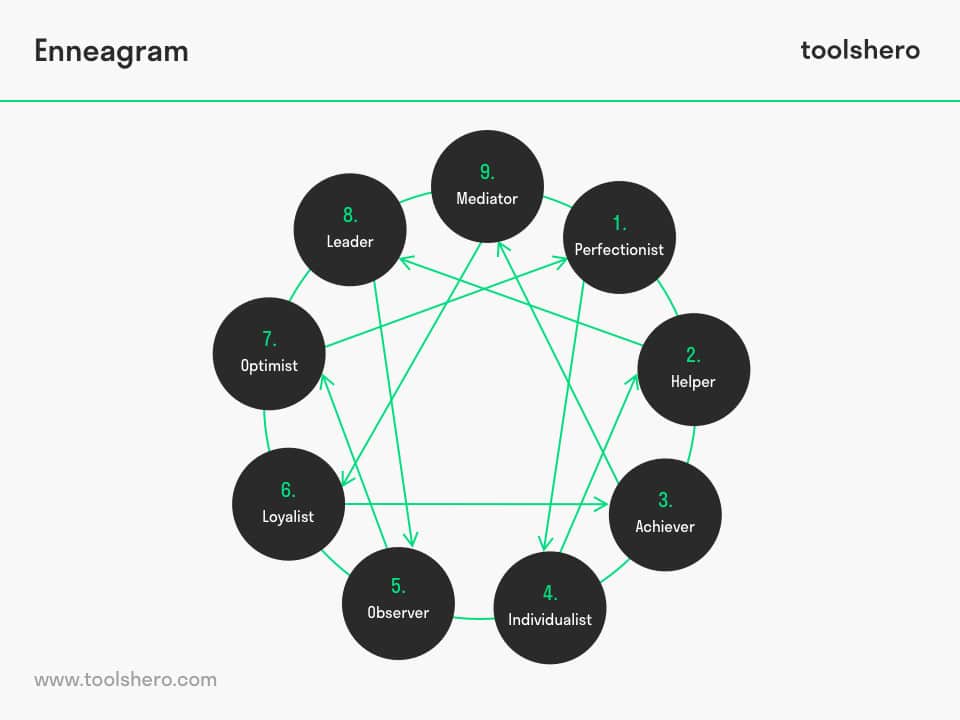Enneagram personality types and test

Enneagram: this article explains the Enneagram in a practical way. In this article you will read about the origins of this method, the different Enneagram personality types and about wings. Wonder what wings are? And there is also Enneagram test available to discover your personality type. Keep reading!
What is the Enneagram?
The Enneagram is an age-old model, in which nine personality types are described. The Enneagram model is thought to have originated in the Middle East and is still used to understand human behaviour.
The name is derived from the Greek language. “Ennea” means “nine” and “grammos” means “movement” or “something written”. The enneagram is represented by a nine-pointed polygon.
History of the Enneagram
Around 1900 , the Enneagram was introduced to the west by the Armenian Georgi I. Gurdjieff. As a spiritual teacher, he used it as a cosmological model. He made the distinction between essence (a person’s real being) and personality.
The Father of the modern variety of the enneagram is Oscar Ichazo, who wrote a book about this in the 1950s. The enneagram was first used by psychologists in the 1970s. To date, the enneagram is regarded as a pseudo-scientific method to identify personality types.
Connections within the Enneagram
Nine personality types are linked to the Enneagram and they are each connected by a fixed point and lines. The relationships of the personality types. A test can provide clarity about this.

Figure 1 – Enneagram Personality Types
The Enneagram Nine personality types
The Enneagram is about essence. Each passion has got an aspect, The enneagram describes nine basic models of our behaviour. The typing of each of the nine personality types is a description of needs, assumptions and positive and less positive motives in life. By gaining an insight into the enneagram, people will be able to understand their own behaviour and that of other people. Furthermore, it also provides suggestions for personal growth:
Enneagram Type 1: the Perfectionist
The perfectionist wants to excel at everything. A perfectionist is realistic, conscientious, thorough, principled and a control freak. Everything has to be perfect and they are incredibly critical. They have got a lot of discipline and they are dependable and orderly. Their disadvantage is that they are too demanding, overly critical and impatient.
Type 2: the Helper
The helper wants to be liked. They are ready to help. They are involved and caring. They are inclined to be self-effacing and they find it difficult to say ‘no’ Their disadvantages are that they can be meddlesome, jealous and possessive.
Type 3: the Achiever
The achiever wants to be successful and obtains the best results by working hard. They are energetic, optimistic, self-confident and target-oriented. This is why they are very efficient and decisive. Their disadvantages are that they can be selfish and calculating as a result of which they ignore other people’s feelings.
Type 4: the Individualist
The individualist is an emotional person, very perceptive but experiences ups-and-downs. They like depth and hate routine jobs. Their disadvantages are that they can be emotionally unbalanced and they often exaggerate.
Course: the Enneagram: Nine Types In Depth
Type 5: the Observer
The observer is eager to learn, sober, analytical and insightful. They rationalize things logically and keep their distance emotionally. Their disadvantages are therefore that they can come across as cold and emotionless and that they are sealed off from the outside world.
Type 6: the Loyalist
The loyalist needs safety and security and has a great sense of responsibility. Therefore, they are dependable and they stick to the rules. Their disadvantages are that they are doom-mongers and that they can be overly suspicious.
Type 7: the Optimist
The optimist is energetic, lively and optimistic. Their disadvantages are that they can come across as shallow, react too impulsively and lose themselves in unrealistic dreams.
Type 8: the Leader
The leader has much self- confidence, is direct, independent and protective. They are not afraid of anyone or anything and they will enter into conflict if need be. Their disadvantages are that they can come across as intimidating and that they can be selfish and even vindictive.
Type 9: The Mediator
The mediator strives after unity and wants to live in harmony with other people. They look at different angles and they can see the benefits and disadvantages of situations. They are good negotiators and they adapt quickly. Their disadvantages are that they are very easily distracted and can come across as indecisive. Moreover, they need to prioritize.
Wings
In addition to the dominant personality type, there are to other important types. These are the so-called “wings“, that balance the dominant type. The two personality types that score just under a top 3, can be found next to the dominant type. Therefore, a perfectionist (1) has wings of a negotiator (9) and helper (2). These wings are not equally strong in all types. The nine types are related in a structured manner. In a relaxed situation, the good qualities of the type move against the arrow. In a tense situation, the type takes on some of the bad characteristics the arrow points to.
Understanding the Enneagram
This model is concerned with conscious and unconscious behaviour and indicates the motivation from which people act or think in many circumstances. Furthermore, it provides an insight into someone’s own character and relationships with other people.
Through this model, people can discover their own strengths and weaknesses and motivations and those of other people. It is often used by managers to understand the different types of employees and have them work together in a better way.
Enneagram test
To get know which Enneagram personality Type you are, you can download this Enneagram test (in Excel format), fill it in and discover your personality Type.
Download the Enneagram test
This template is exclusively for our paying Toolshero members. Click here to see if a membership is something for you!It’s Your Turn
What do you think? What is your experience with the Enneagram? Do you recognize the practical explanation above or do you have additions? What are your success factors for a good self-analysis or Enneagram test?
Share your experience and knowledge in the comments box below.
More information
- Baron, R., & Wagele, E. (1994). The Enneagram made easy: discover the 9 types of people. Harper Collins.
- Hendrix, T. (2014). The Enneagram: Nine Types In Depth. Retrieved 02/26/2024 from Udemy.
- Hudson, R. (2000). Understanding the enneagram: The practical guide to personality types. Houghton Mifflin Harcourt.
- Hudson, R., & Riso, D. R. (1999). The Wisdom Of The Enneagram: The Complete Guide To Psychological And Spiritual Growth For The Nine Personality Types. Bantam.
- Palmer, H. (1991). The Enneagram: Understanding Yourself And The Others In Your Life Author. HarperOne Pages.
- Palmer, H. (1996). The Enneagram in Love and Work: Understanding your Intimate and Business Relationships. HarperOne.
- Riso, D. R.; Hudson, R. (1999). Wisdom of the Enneagram. ISBN 0-553-37820-1.
- Wagele, E. amp&; Stabb, I. (2010). The Career Within You. HarperOne. ISBN 978-0-06-171861-8.
How to cite this article:
Mulder, P. (2013). Enneagram personality types. Retrieved [insert date] from Toolshero: https://www.toolshero.com/psychology/enneagram/
Original publication date: 03/11/2013 | Last update: 02/26/2024
Add a link to this page on your website:
<a href=”https://www.toolshero.com/psychology/enneagram/”>Toolshero: Enneagram personality types</a>












